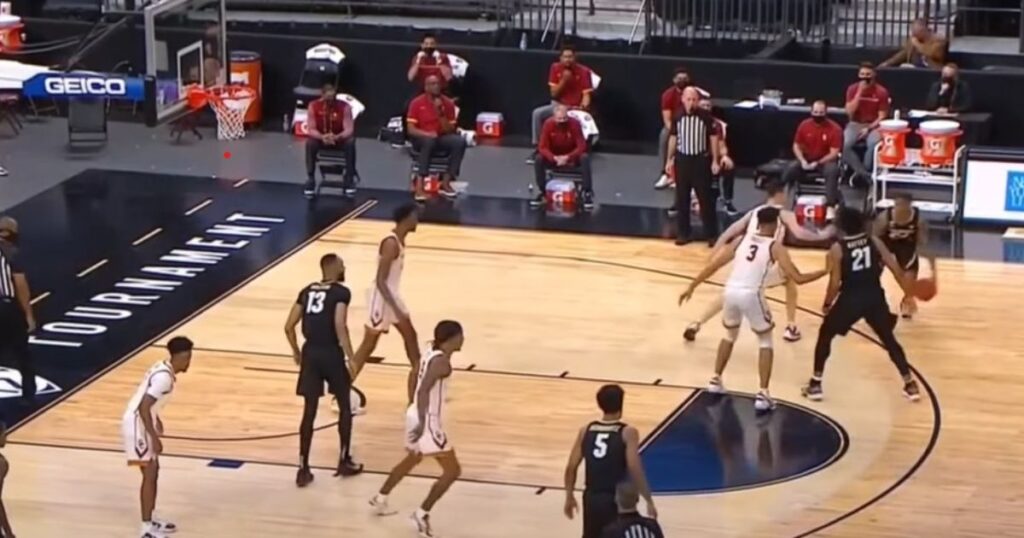What is Drop Coverage -The pick-and-roll is a fundamental play used across all levels of basketball. When faced with a pick-and-roll situation, teams often employ a defensive strategy called “drop coverage.”
Let’s break down what drop coverage is, how it works, and the responsibilities of each player involved.

Related: Usyk vs Fury Fight 2024: Heavyweight Glory on the Line
What Is Drop Coverage?
Drop coverage is a defensive scheme primarily employed during pick-and-roll plays.
- It focuses on the defender guarding the screener (the player setting the screen).
- The key idea: The screener’s defender drops back toward the basket, creating a “wall” to prevent the ball handler from driving to the hoop.
Let’s break down its components:
- Pick-and-Roll (P&R):
- The pick-and-roll is a fundamental offensive play where one player (the screener) sets a screen for the ball-handler (the guard or point guard).
- The goal is to create an advantage by forcing the defender guarding the screener to make a decision: either switch onto the ball-handler or stay with the screener.
- The Role of the Screener’s Defender:
- Keep the Ball in Front:
- The screener’s defender must prevent the ball-handler from getting close to the rim for an easy shot.
- Keep the Roller in Front:
- The defender must also prevent the roller (the player who set the screen) from getting deeper than they are. Allowing the roller to slip behind the defense risks an alley-oop pass.
- Keep the Ball in Front:
You may want to read : What is Memorial Day 2024: Why Is It Celebrated?
How Drop Coverage Works
- Communication:
- Effective drop coverage begins with communication. The screener’s defender must alert their teammates about the impending screen.
- For example, if the screen is coming from the left side, they call out, “Screen left!”
- No Rejections:
- The on-ball defender (guarding the ball-handler) prevents the ball-handler from rejecting the screen.
- Rejecting the screen would disrupt the drop coverage.
- Positioning:
- The on-ball defender goes over the top of the screen, staying close to the ball-handler.
- The screener’s defender drops back, creating a barrier near the paint.
- This positioning prevents the ball-handler from driving to the rim.
- Balancing Responsibilities:
- The screener’s defender must:
- Keep the ball-handler in front to prevent easy drives.
- Keep the roller (the screener) from slipping behind the defense for an alley-oop pass.
- It’s a delicate balance—too far back, and the ball-handler has an open shot; too close, and the roller gets an easy basket.
- The screener’s defender must:
Variables and Scouting
- Offensive Abilities:
- The decision on how far the screener’s defender drops depends on the offensive abilities of both players.
- If the ball-handler is an excellent shooter, the defender may not drop as far.
- If the roller is a lob threat, the defender must be cautious.
- Coaching and Practice:
- Coaches drill drop coverage extensively in practice.
- Players need to react instinctively during games, adjusting based on the situation.
Implications and Impact
- Strengths of Drop Coverage:
- Interior Defense: Drop coverage protects the paint, making it harder for opponents to score inside.
- Controlling the P&R: It disrupts the pick-and-roll by limiting driving lanes.
- Weaknesses of Drop Coverage:
- Perimeter Shooting: If the ball-handler is an excellent shooter, drop coverage can lead to open jump shots.
- Adaptability: Teams with versatile big men who can shoot from outside pose challenges.
When NOT to Use Drop Coverage in Basketball
When the Ball-Handler Is an Elite Shooter
- Issue: Drop coverage involves the screener’s defender dropping back to protect the paint. However, if the ball-handler is an exceptional shooter from beyond the arc, this approach can backfire.
- Solution: Consider a more aggressive approach, such as hedge-and-recover or switching, to prevent open three-point shots.
When Facing a Versatile Big Man
- Issue: Drop coverage assumes that the roller (screener) will primarily attack the rim. If the opposing team has a big man who can shoot from mid-range or beyond, drop coverage becomes risky.
- Solution: Adjust the coverage based on the specific player. For versatile bigs, consider hedging or switching to disrupt their rhythm.
When the Game Situation Demands Pressure
- Issue: Drop coverage can be passive, allowing the ball-handler to dictate the pace. In high-pressure situations (e.g., late-game scenarios), a more assertive defense may be necessary.
- Solution: Opt for aggressive traps, double-teams, or full-court pressure to force turnovers and disrupt the offense.
When the Screener Is an Excellent Roller
- Issue: If the screener is an exceptional roller with great hands and timing, drop coverage might not be effective. They can slip behind the defense for easy alley-oops.
- Solution: Mix up coverages. Sometimes hedge, sometimes drop, and occasionally switch to keep the offense guessing.
Conclusion
Drop coverage is a chess match within the game of basketball. Coaches and players must understand its nuances, adapt to opponents, and execute it flawlessly. When done right, drop coverage can stifle even the most potent pick-and-roll offenses.
So, next time you watch a game, pay attention to the defensive rotations—the subtle dance of defenders dropping back to protect the rim. It’s drop coverage in action! 🏀🔒
For more in-depth insights, check out the article on Drop Coverage in Basketball.
Learn more basketballforcoaches.com ,metroleague.org ,basketbalteam.com
You may also like: